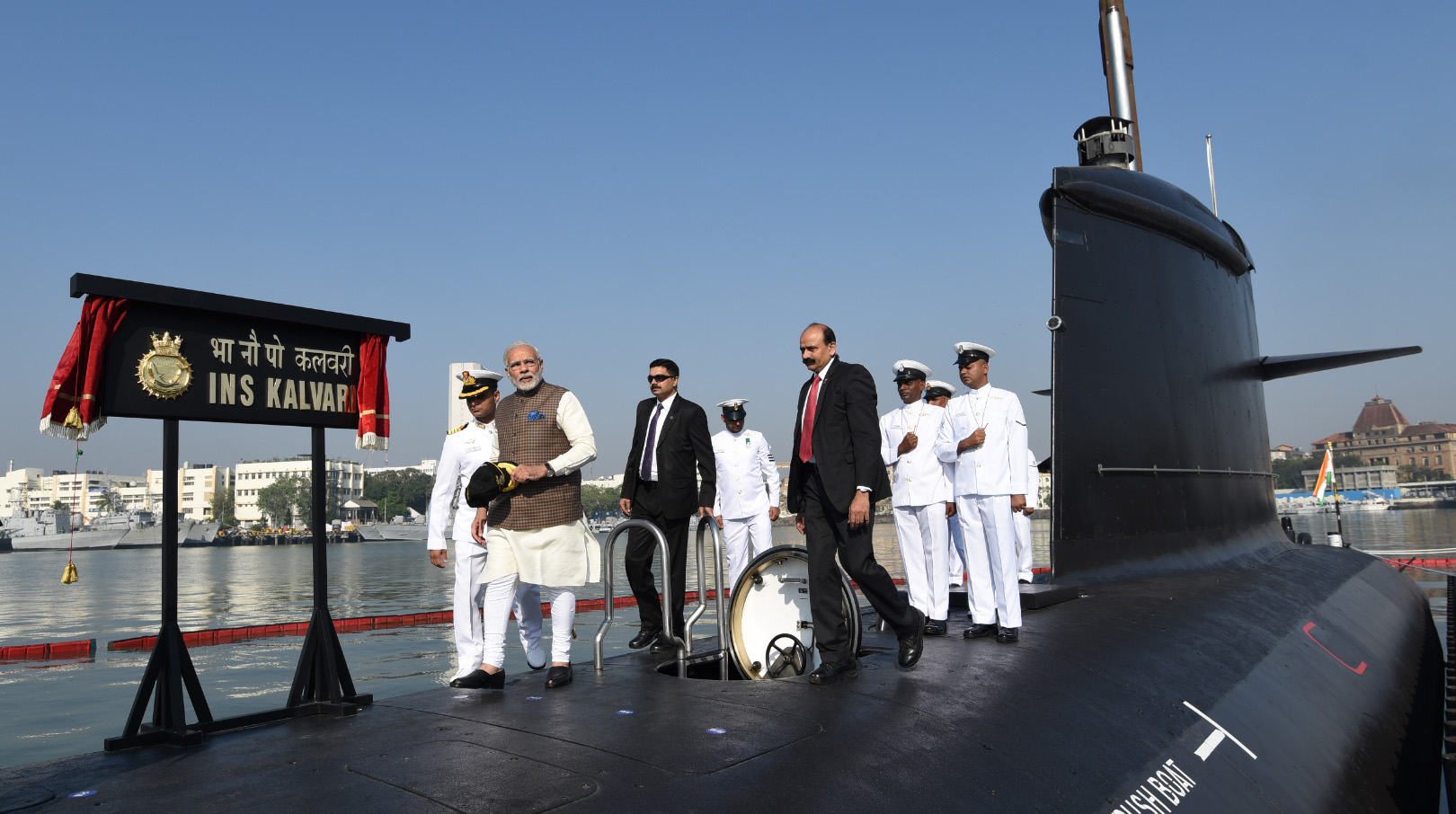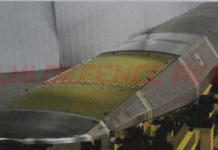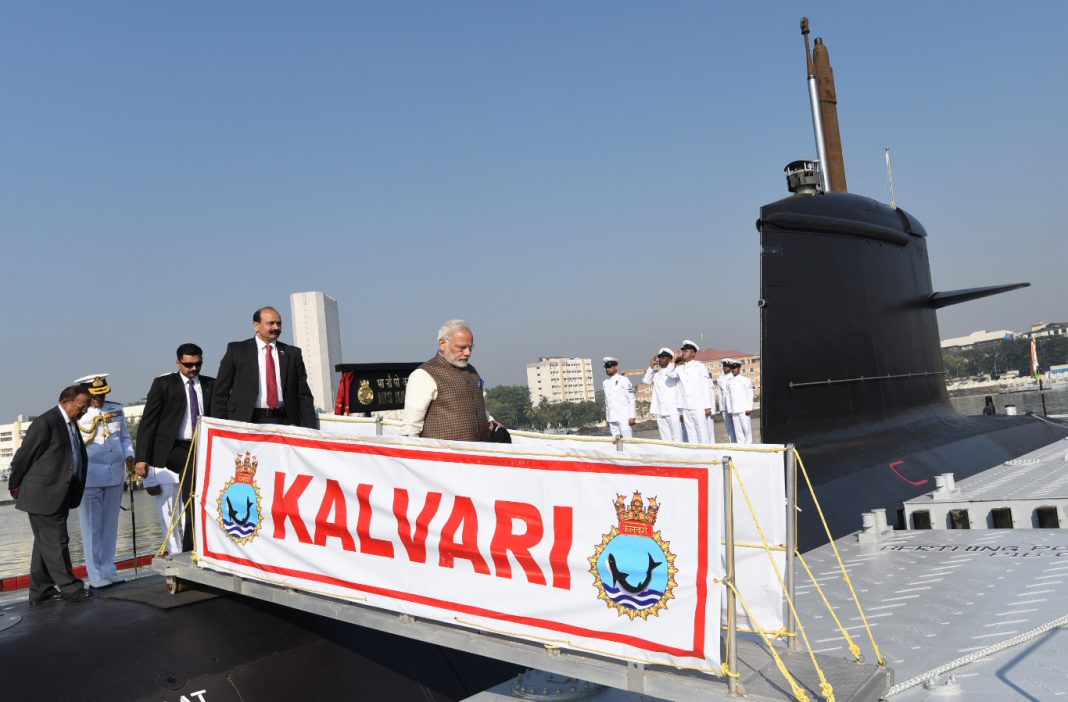The Indian Navy’s (IN’s) first Scorpene class submarine, the INS Kalvari, was commissioned earlier today at the Naval Dockyard in Mumbai in a ceremony presided over by Prime Minister Narendra Modi. While construction began in 2006, INS Kalvari headed out for sea trials only in 2016 and there were a few more minor delays before the boat was officially inducted. The overall programme, called Project 75, to construct six Scorpene submarines domestically with transfer of technology from France’s Naval Group at a cost of Rs 23,562 crores, has been dogged by various controversies over the years, not the least of which was the reported ‘leak’ of some 22,400 documents purportedly related to the operational characteristics of the IN’s Scorpenes. Nonetheless, INS Kalvari’s commissioning does mark a revival of the practice of ‘diesel-electric submarine’ (SSK) construction in India, given that the last SSK built in India by Mazagon Dockyard Limited (MDL), still India’s only shipyard that actually builds SSKs, was commissioned in 1994 and that too with a different foreign collaborator.
Indeed, the delays in construction are reflective of the time taken by Indian project managers and workmen to imbibe French submarine design and construction methodologies, which though in tune with global best practices in terms of modularity and integrated hull outfitting, do have their peculiarities. Moreover, though indigenous content in the Scorpene class boats is only between 30-40 percent, the project has helped enlarge the local vendor base capable of producing marine grade equipment. The second unit of the now Kalvari Class (since INS Kalvari has been commissioned), the ‘Khanderi’, was launched in January 2017 and is currently undergoing sea trials. ‘Karanj’, which is the third boat of the class is likely to be launched in the next few months. The remaining three boats of the class are presently in various stages of construction and the last boat is expected to be delivered by the end of 2020. With Project 75 clearly out of the stovepipe and into the light, it is time to take a closer look at some of the features of INS Kalvari and her sisters.
The build story

Image: Indian PM Narendra Modi aboard INS Kalvari during this morning’s commissioning ceremony. Source: PIB
The overall length of INS Kalvari is 67.5 metres (m) and its height is 12.3 m. Being derived from Naval Group’s Scorpene-2000 offering, this boat has a submerged displacement of 1585 tonnes. Its construction began in 2006 at MDL Yard 11875, with the completed hull being hauled out from dry dock on a submarine launch pontoon in April 2015 and the boat put out to sea for the first time, only last May. The submarine was delivered to the IN in September this year prior to today’s commissioning.
So over a decade has gone into getting the first Scorpene ready for service, even as MDL learnt the principles of contemporary submarine construction, with a French accent. INS Kalvari was built using a modular approach, whereby five separate sections (all built in parallel) were welded together in a process known as the ‘boot together’. (Of course, strictly speaking the boot together refers to the last two sections of the submarine being joined together which have been formed out of the original five). Now, the building of the submarine itself started with the fabrication of ring frames which was followed by plate forming. These were then assembled into sub-sections that went into the five separate sections used for the ‘boot together’. Even as the sections were being fabricated, the outfitting of shock-resistant cradles with mission equipment was being taken forward in parallel. The outfitted cradles were then embarked into the five major sections, which were then lowered onto the dry dock pontoon mentioned earlier, prior to the ‘boot together’. INS Kalvari’s ‘boot together’ happened in July 2014.
Hull and more

Image: INS Kalvari at its commissioning ceremony
Now the structural material used for the pressure hull of this submarine is a high-yield stress-specific micro-alloy steel called ‘80 HLES’. As such, 80 HLES is used extensively in French submarine construction and has characteristics such as very high mechanical strength while retaining the ability to be cut, formed and welded together using standard methods.
The high yield and tensile strength of this steel allows the pressure hull to be lighter than it would be with a material that is less tough, thereby facilitating the carriage of more fuel and ammunition on board. The use of 80 HLES also makes the hull capable of withstanding high hyrdrostatic force levels, thereby enabling deeper dives, which is turn leads to greater stealth in operations. The ‘test depth’ of INS Kalvari is likely to be 350 m. As an aside, HLES is a classification used in Europe and is basically equivalent to the HY 100 steel used in the United States (US) for naval construction. Arcelor Mittal’s subsidiary Industeel is a known supplier of 80 HLES.
INS Kalvari’s albacore bow shape, propeller scheme, overall hull form which has fewer appendages (i.e forward and aft control surfaces) than legacy forms, and the appendages themselves, have all been specifically designed to minimize hydrodynamic resistance leading to a lowering of radiated noise levels. The positioning of equipment on suspended shock-resistant cradles by using elastic mountings also contributes significantly to emitted noise reduction. In fact, the loudest pieces of equipment are put on double-elastic mountings. As such, it can be said that INS Kalvari boasts a greater degree of acoustic discretion than other submarines currently operating in the Indian Ocean Region (IOR).
The Kalvari’s low-noise signature and advanced hydrodynamics confers upon it the characteristics necessary to perform a range of missions in the IOR by utilizing an advanced sensor and weapon suite, some details of which we shall see later. The submarine, besides being able to conduct standard missions such as, mine-laying, intelligence, surveillance and reconnaissance (ISR), anti-submarine warfare (ASW) and anti-surface warfare (ASuW), in both open and closed sea conditions, will also be able to insert special forces (SF) troops via littoral waters. Being highly automated, INS Kalvari has a complement of only 31 personnel, leaving enough ‘space’ for six SF troops and their equipment.
INS Kalvari also has two refuge compartments which can be used to rescue personnel in the event of an accident, by using the two deep-submergence rescue vehicles that the IN is procuring from Britain. It also has a cofferdam as an added safety feature.
Propulsion
While underwater, the Kalvari’s stealthy mass is propelled due to the power supplied by 360 lead acid batteries, each weighing some 750 kg, to a 13-phase permanent magnet synchronous motor developed by Naval Group-AREVA-Jeumont , which turns the propeller. The quiet synchronous motor is itself mounted on a shock-resistant cradle. The batteries are charged by two 1250 kW MAN diesel engines. Of note is the fact that at the top of the hull immediately above the diesel engines is a so-called ‘Dutch Breach’ that facilitates easy removal of these engines for maintenance and overhaul. This propulsive arrangement should give the Kalvari Class boats a top speed of 20 knots per hour underwater and a submerged endurance of six days or the ability to traverse 1,020 km underwater without the need to surface.
As we have written before, once INS Kalvari is due for its first major refit, an air-independent propulsion (AIP) system developed by the Naval Materials Research Laboratory, which is a part of the Defence Research & Development Organization (DRDO) will be incorporated into the hull of this submarine by first cutting it open. This will subsequently be done to the rest of the Kalvari Class boats as well, once they come in for their first refits.
Sensors
The quiet hull and propulsive machinery provide INS Kalvari a stealthy base, as it were, to carry out a wide range of missions whose efficacy is contingent upon the performance of the boat’s sensor suite and navigation set up. The submarine’s sonar suite is the Thales supplied TSM 2022 MkIII, which according to the manufacturer is capable of long range low-frequency (LF) detection, high frequency (HF) detection, LF minimum detectable velocity tracking, LF mine avoidance, VHF shadow classification, HF and VHF route survey as well as HF moored mine classification.
Scorpenes sold to a user other than the IN are equipped with EDO Reconnaissance Systems and the AR-900 electronic support measures/direction-finding (ESM/DF) system from Harris. It cannot be confirmed whether INS Kalvari has the same fit and it is possible that INS Kalvari uses French sourced equipment for these purposes. INS Kalvari does have two Sagem supplied optronic masts, with one meant for attack and the other for surveillance. These are equipped with Infrared/ low-light level cameras and laser range finders.
INS Kalvari has a high accuracy ring-laser gyroscope (RLG) at the core of its integrated navigation system which also combines data from multi-constellation satellite updates, the boat’s log, depth measurement devices and its trim / list monitoring system. INS Kalvari has on-board sensors for recording seawater density and temperature as well as its own acoustic signature in the environment it’ll operate in. Going by standard IN practice, it can be surmised that INS Kalvari should be able to receive very low frequency (VLF) messages via a trailing antenna as well as encrypted burst communications when surfaced.
Ready for combat
The various sensors on board INS Kalvari and any data received by it from external sources will all feed its combat management system (CMS) called the Submarine Tactical Integrated Combat System (SUBTICS). SUBTICS, reportedly ‘has six multifunction common consoles and a centrally situated tactical table, which is collocated with the platform-control facilities’. It has a command and tactical data handling system and a weapon control system which it integrates with the boat’s suite of sensors and navigation set up.
Once informed by its ‘sources’, SUBTICS can choose to engage enemy targets with INS Kalvari’s weapons suite which includes the sea skimming SM-39 Exocet anti-ship missile (AshM) with a range of 150 km and a payload of 150 kg and the heavyweight 533 mm AEG-SUT Mod 1 torpedoes, which are already in use with the IN’s Shishumar Class submarines and will be an interim weapon for the Kalvari Class boats. These weapons will be released via INS Kalvari’s six Weapon Launching Tubes (WLT), which can be reloaded at sea. INS Kalvari is also kitted out with the C303/S anti-torpedo countermeasure system for self-defence.
Prospects for Indigenization
Though the indigenous content (IC) level is INS Kalvari is not high due to contract stipulations and other issues, Project 75 has nevertheless drawn upon Indian industry to source items such as weld consumables, ventilation coamings, cables, anechoic tiles, GRP casing panels, the lead acid main batteries etc. Moreover, equipment such as the thrust block, hydraulic blocks, hydraulic plungers and hydroplanes were machined in India with material imported from abroad. The IN believes that given its domestic vendor base, equipment such as different types of pumps, AC plants, accumulators, various types of filters and the demineralised water plant could all be indigenized progressively.
Greater IC levels are intended for any follow-on order for three more Kalvari Class boats as is being reportedly mused by New Delhi. However, systems such as CMS and optronic masts are likely to be imported for any follow-on units. The current RLG used on board could in theory be replaced by one developed by DRDO, which recently supplied the IN with a high accuracy RLG for surface ships. DRDO’s Research Center Imarat is known to be developing high accuracy mirror-based RLGs that can be used on-board submarines.
Beyond the use of indigenous equipment in Project 75, is the development of human resources that has taken place as a result of the programme. MDL now has people who are well familiarized with the construction process, documentation and quality/assurance procedures followed by the French while building SSKs such as the Scorpene. Personnel from both MDL and the IN have gained considerable expertise and knowhow with respect to contemporary welding craft and technology, test procedures and acceptance criteria. Thanks to this build programme, India now has a number of welders qualified in major metal arc welding techniques used to build pressure hulls.
Obviously, fabrication pedigree through Project 75 did not come overnight. For instance, there were setbacks related to even cutting and rolling the steel used to fabricate hull sections. But today, rejection rates have become quite low as a result of learning by doing. Packaging equipment on board the major sections of INS Kalvari is no mean task. Nor is the issue of ‘connecting’ systems together via some 60 km of cabling and a further 11 km of piping. Beyond MDL, outsourcing to private vendors has also led to a qualitative improvement in their build standards due to the stringent tolerances demanded by the program.
Overall INS Kalvari’s commissioning marks a new day for SSK construction in India. The learnings are likely to be ported to Project 75I, which envisions the domestic construction of six more SSKs of contemporary design with foreign collaboration, possibly by a yard other than MDL. Meanwhile, MDL says that its hull fabrication unit is fully oiled awaiting follow-on orders.
Saurav Jha is the Editor-in-Chief of Delhi Defence Review. Follow him on twitter @SJha1618
© Delhi Defence Review. Reproducing this content in full without permission is prohibited.
































